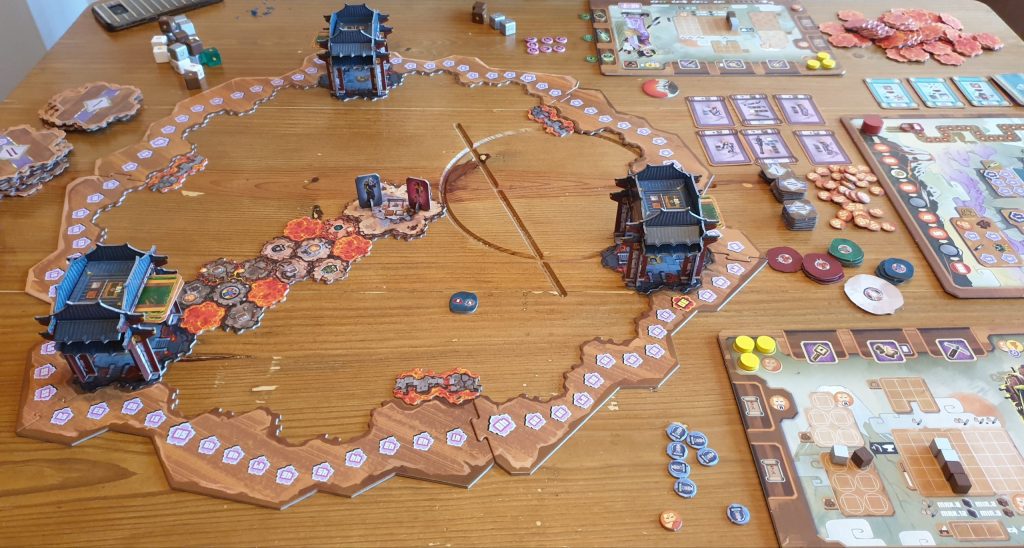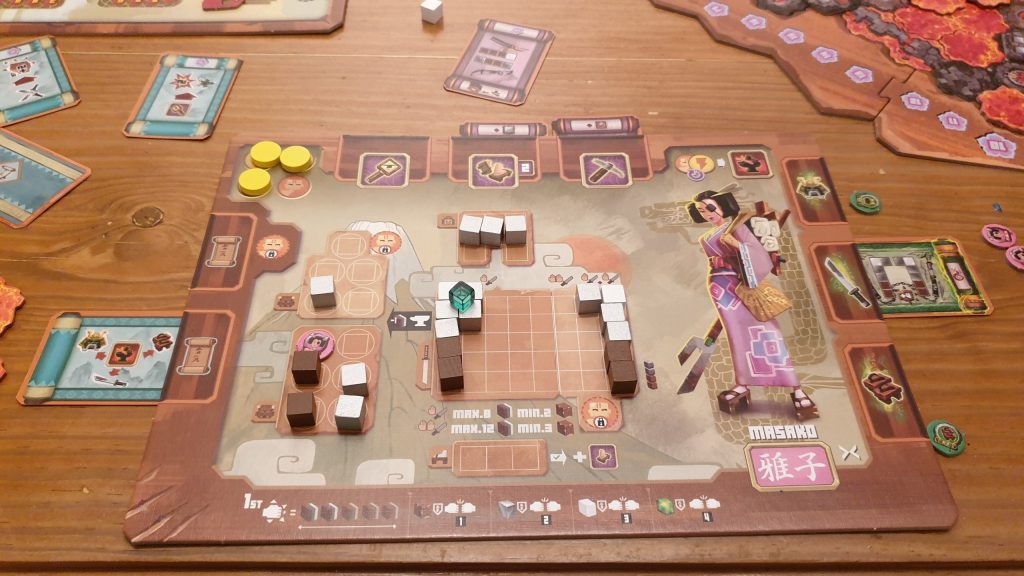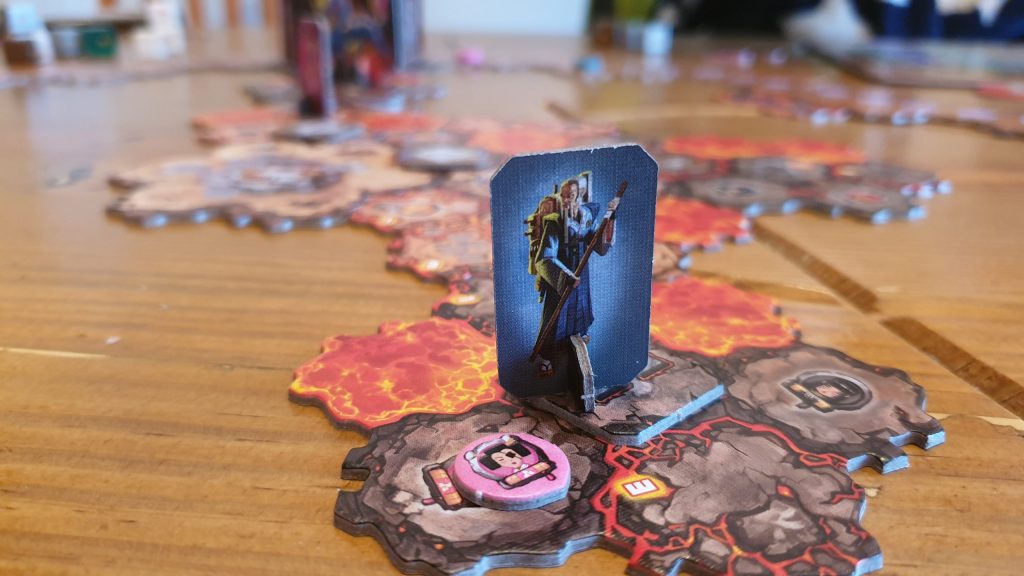Fuji Koro released at the end of 2019, after a successful Kickstarter campaign by publisher Game Brewer. Designed by Jerome Demeyere, featuring artwork by Miguel Coimbra, the game has exploration gameplay, driven by tile placement, and dice driven combat. 1 – 6 players will spend around an hour and a half collecting resources, exploring the volcano, maybe escaping it and dealing with the dragons. However, does the fun erupt out of the experience? Let’s find out!
With Mount Fuji on the brink of erupting players take up the roles of samurai, working for the Shogun to grab what they can from inside. Relics, scrolls, monks and more need to be saved, with the Shogun ready to reward those that retrieve things. At the start of the game the outer edge of the volcano, with three sacred temples, and a single centre tile are the only pieces placed. Stacks of tiles ready to be explored are placed within reach and the central board is ready. A player standee for each samurai just needs to be placed on the middle tile.
Each player gains a player board, 3 action tokens, some matching samurai tokens, a monk and some starting resources for a pretty poor weapon. On a turn the active player gets to perform two actions. While some can be improved they are: move, explore, gather and rest. By default players can move 2 spaces, and not across hexagons of lava if barefoot. When at the edge of a tile, like the starting central tile, a player can explore. This sees the player take the top most tile and add it as an explored region adjacent to the tile they are on. Tiles come in three tiers – with the level of tier used depending on the banding away from the central tile. While level 1 tiles, that touch the central tile, are not worth points, level 2 and 3 tiles are worth points to the explorer.
Players will need resources. Gathering is the action to solve this. When exploring some hexagons will spawn in with monks, player scrolls and resource tiles. Using the gather action the player gains what is on their hexagon, though they cannot obtain their opponent’s scrolls. Gathered items are placed into the players backpack, with items unable to be stored discarded. Resource wise this will be the main source of wood and iron.

Gathering a monk token can help in multiple ways. Sections of the player board are locked until a monk is obtained. This can see the player’s backpack hold more, the ability to hold a larger two handed weapon or even have an additional action token. Monks are even good later on when escaping the volcano to earn bonus points.
At some point players will either have no action tokens less or will just wish to rest. This sees their action tokens reclaimed, with the option to then craft. With the resources available to them the player chooses either the helmet, their weapon or sandals to craft. Helmets are used to sponge damage from dragon attacks. Weapons give players their initiative and the dice they’ll use against dragons. Sandals will allow players to walk across hexagons of lava, taking damage each time.
Crafting specifically shaped items, with the right materials, can earn the player blueprints or complete magical blueprints. While magical ones need to be gathered from the sacred temples, regular blueprints are simply earnt when the pattern is completed. These upgrade one of the three non-rest actions, from allowing a 1 space movement to earning a victory point. This can legitimately make moving earn a player points, an iron cube or more.
Some of the tiles will see dragons, of varying colour, spawn. Each colour is a tier of sorts with blue dragons being the weakest, up to the white dragon, though each has slight variations. Each dragon comes with initiative and health values, alongside how many dice it’ll attack with and the number of victory points earnt for defeating it. By moving onto a tile with a dragon combat is triggered, with other samurai on adjacent hexagons able to join in.

Whomever has the highest initiative rolls first. Players dice are determined by what their weapon is made of, with brown dice for wood able to deal up to 1 damage and white dragon teeth dice able to deal up to 3 hits. Hits are calculated and health is reduced accordingly for dragons. Players remove cubes from their helmet to mitigate the damage – with each material cancelling a different amount of damage. During the fight the dice rolled can have break symbols, seeing the player gain dragon teeth cubes or cubes fall off their weapon. The fight continues until the player slays the dragon or the player’s helmet is destroyed and additional damage is received, knocking the samurai temporarily unconscious.
Fuji Koro continues with players exploring and attempting to kill dragons until one player reaches 30 points. At this point the end game is triggered, with 8 full rounds left. In this section of the game the round could see hexagons flooded with lava or the escape rope added to the board. Samurai who escape the volcano then cash in monks, magical weapons and more for bonus points. Whomever has the most points at the end is the winner.
Fuji Koro is a game that will draw the attention of those nearby. It has a stunning map that grows into a beautiful volcano landscape. The way the players slowly explore the map is an amazing core to the game. The resource collection and crafting system offers the players ample choice. Do you attempt to build a huge weapon, collect that monk for extra backpack space and is it worth going for a blueprint? Every choice has an impact on the outcome of the next fight or even whether you can finally escape the volcano.
The combat feels a little convoluted compared to the rest of the rules, coming with many more caveats. Exploring is effectively flipping a tile, placing it how you’d like and maybe scoring points. Even to get one of the blueprints it is as simple as matching the pattern to obtain the card. Crafting players need to worry about bits breaking in combat, but when crafting the cubes in a zone can be rearranged freely. This results in the same element unituatively reacting differently depending on the situation. Initiation is also a forgettable mechanic, based on weapon length. Plus, once past green and blue dragons it is almost pointless dragons having initiation as players simply cannot beat their value.

At the start of the game players want resources for their helmet, weapons and sandals. By the mid game however players will have unlocked scrolls and blueprints to help their income of cubes. When it gets to towards the end of the game there is nothing to do with the abundance of cubes in your backpack. This is a nice balancing act for players to play, you don’t want to waste too much time on wood – yet it could give you a major early game advantage.
Component wise, the beautiful volcano tiles are marred by odd jigsaw-like sides which are a pain to force together. The concept is strong so that the tiles lock together, removing the chance of being knocked. Alas, it creates some irritation when placing tiles, especially with them not fitting perfectly within the scoring track – the outer edge of the volcano. The various tokens are just about on the cusp of fiddliness, though their size is limited to fit onto the board and player boards. The dragons are done nicely, though plastic clips to make them standees rather than the cardboard ones used would have elevated the title somewhat.
Fuji Koro seems to be somewhat of a confused game. Players can choose whether or not to include player combat. The game can be played competitively or cooperatively. The rules don’t seem to want to commit to one way to play. Different variants will appeal to different people. Alas, it creates a learning process that could do with streamlining. The components aren’t perfect but do create a visually stunning game. The dragon combat is luck driven though there are chances to mitigate, and players are able to gain many points without ever fighting. Thankfully, the core of exploring, gathering and crafting – with the action token system that drives it – works to make Fuji Koro worthy of at least a play.
(Editor’s Note: Fuji Koro was provided to us by Asmodee for the review. The game is currently available from local board game stores, find your local store here.)

